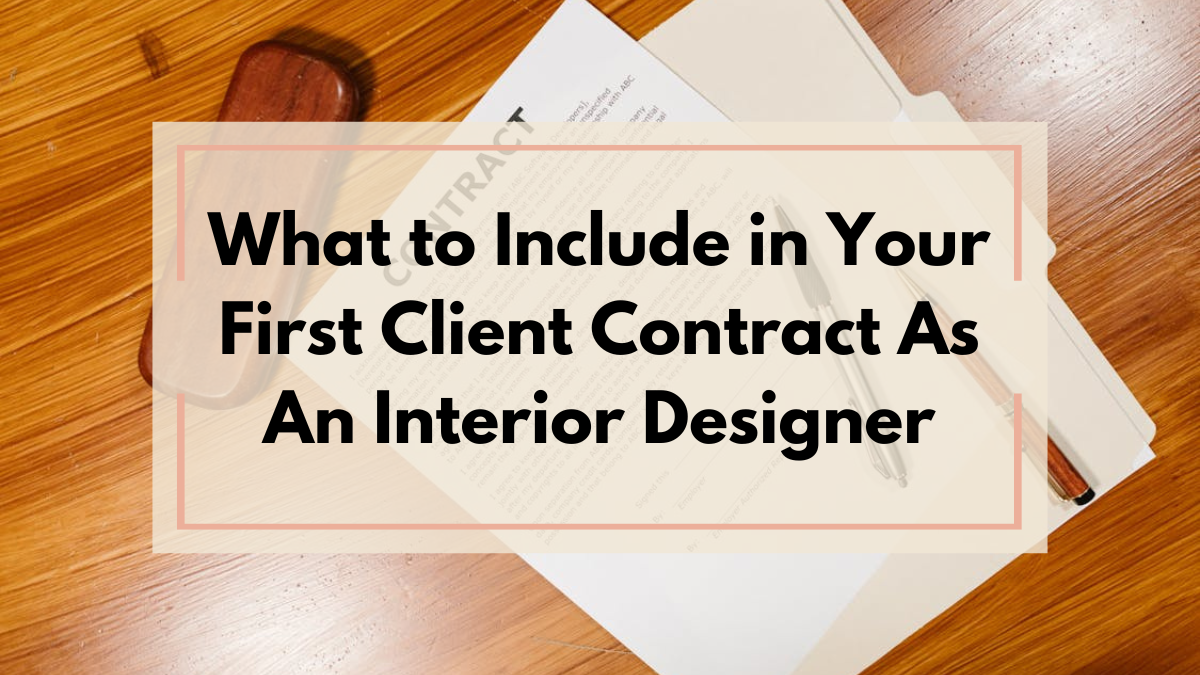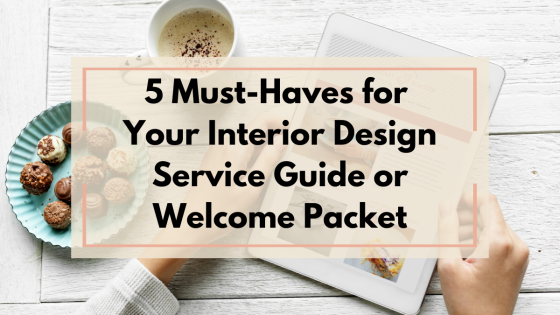What to Include in Your First Client Contract As An Interior Designer

If you're an interior designer starting to take on client projects, congratulations! That first official inquiry is a big moment. But before diving into mood boards, site visits, or samples, there’s one thing that deserves your immediate attention: your client contract.
Think of your contract as the backbone of your business. It sets expectations, outlines deliverables, protects you legally, and helps create a smooth experience for your clients. And yet, many designers either skip this step or use something too generic to truly serve them.
Whether you’re new to running your own design business or you've been operating more casually for years, having a solid contract in place can make all the difference when scaling sustainably. It shows professionalism, builds trust, and saves you from headaches down the road.
In this article, I’ll walk you through the key elements every interior designer should include in their very first client contract—simple, clear, and protective for both you and your client.
#1: Scope of Work
The foundation of any good contract is a clearly defined scope of work. This section outlines exactly what services you are providing, and just as importantly, what you’re not providing.
Include specifics such as:
- Number of design concepts
- Room(s) being designed
- Revisions included (and how many)
- If sourcing and purchasing are included
- Whether project management or contractor oversight is part of your services
Why it matters: Clients often expect more than what’s been discussed, especially if they’re not familiar with the design process. A detailed scope keeps both sides aligned and protects you from doing unpaid work. When everyone knows what’s expected, there’s less room for misunderstanding or scope creep.
Pro Tip: Use bullet points to make the scope easy to read, and avoid vague language like “full-service design” without defining it.
68374ba0cb57f_lg.png)
#2: Project Timeline
Set realistic expectations for how long the project will take. This doesn’t mean you need to give an exact end date, but providing a general timeline or key milestones (like concept delivery or install week) gives your client a sense of structure.
Also consider including:
- What happens if there are delays
- How you handle changes to the timeline
- Padding your timeline to allow for unexpected delays (e.g., supplier issues or client indecision).
Why it matters: Interior design projects can stretch out longer than expected. Having clear dates provides a framework and encourages accountability on both sides.
Pro Tip: Always add a disclaimer that timelines are subject to change due to factors outside your control, like vendor delays or client feedback delays.
#3: Fees and Payment Terms
Money talk isn’t always easy, but it's absolutely essential. Be clear about:
- Your total fee
- How and when payments are due (e.g., 50% upfront, 25% midway, 25% on completion)
- Late payment penalties
- Refund policies
If you charge hourly, include your rate and how you track time. If you work on flat fees or packages, list exactly what’s included. This section protects your cash flow and avoids awkward conversations later on.
Why it matters: This section protects your income. Design is not just a creative service, it’s a business. Clear financial expectations ensure you’re paid fairly and on time.
Pro Tip: Always collect a deposit before beginning any work. It shows commitment from the client and covers your initial time investment.
68374c5f6b7f7_lg.png)
#4: Client Responsibilities
Yes, your clients have responsibilities too! This section sets the tone for a collaborative relationship. You can include things like:
- Timely responses to emails or design decisions
- Access to the space when needed
- Final approval before purchases are made
- Providing accurate measurements or photos if applicable
Making this clear up front helps you avoid project delays due to slow client responses or missing info.
Why it matters: Delays or miscommunication often come from the client’s side. This clause gently reminds them they have a role to play.
Pro Tip: Be firm but friendly in your wording. You’re setting the tone for mutual respect.
#5: Revisions and Changes
Design is a process, and revisions are part of the journey. Still, you need to protect yourself from endless rounds of tweaks.
State:
- How many revisions are included (e.g., 2 rounds of changes)
- How additional changes will be billed
- Cut-off points for revisions (like before sourcing begins)
This keeps the project moving and sets boundaries around your time and creative energy.
Why it matters: Without boundaries, revision requests can spiral out of control, eating up your time and affecting your profit.
Pro Tip: For example, you might say “Includes up to 2 rounds of revisions per design phase. Additional revisions will be billed at $X/hour.”
68374d5393646_lg.png)
#6: Purchasing & Procurement
If you’re buying products on behalf of the client, include a clause that outlines how purchasing works.
Cover:
- Whether you charge a procurement fee
- If clients will reimburse you for purchases
- Your policy on returns and damaged goods
- Whether clients can buy items directly
Also, consider adding a disclaimer that you’re not liable for manufacturing defects or delivery delays from vendors.
Why it matters: Procurement involves a lot of moving parts, and things can go wrong. This section reduces confusion and outlines your responsibility versus the client’s.
Pro Tip: Always clarify whether your design fee includes procurement or if it's an additional service.
#7: Intellectual Property Rights
Design work is your intellectual property. Clarify how your work can be used.
Specify:
- Whether you retain rights to design concepts or visuals
- If clients can share your designs publicly (e.g., social media)
- Your right to photograph and publish the finished project in your portfolio
This is especially helpful if you want to showcase your work or enter design competitions later.
Why it matters: Protecting your IP ensures you retain control of your creative work, which is your business asset.
Pro Tip: Allow clients to use designs only for the intended property and reserve the right to showcase your work (with proper credit and privacy protections).
68374f29a13b2_lg.png)
#8: Cancellation and Termination
Life happens. Clients change their minds, and sometimes projects need to end early.
Include:
- How either party can cancel
- What fees are due if cancellation occurs
- What happens to work completed so far
This section ensures you’re compensated for time spent, even if the project ends prematurely.
Why it matters: Without this clause, you could lose significant income or be expected to issue refunds you hadn’t planned for.
Pro Tip: A fair cancellation policy protects your time and income while respecting the client’s decision to pause or stop work.
#9: Confidentiality Clause
Depending on the nature of the project, your client may want assurance that their home, lifestyle, or financial information stays private.
Why it matters: A confidentiality clause builds trust and shows professionalism. It’s particularly important if you work with high-profile or luxury clients.
Pro Tip: Keep it simple and clear: “Designer agrees to keep all personal and project information confidential and will not share without written consent.”
#10: Dispute Resolution
You hope you never need this section, but if something goes wrong, it’s a lifesaver.
State how disputes will be handled:
- Through mediation first?
- Is litigation an option?
- What jurisdiction governs the contract?
Even if it never comes up, having this clause shows you’ve thought things through professionally.
Why it matters: It helps avoid long and costly legal battles and shows your professionalism in difficult situations.
Pro Tip: Many designers include a clause stating that disputes must be attempted to be resolved through mediation before legal action is taken.
6837fe0f3bd71_lg.png)
#11: Signatures and Dates
This might sound obvious, but it’s often overlooked. Your contract isn’t valid until it’s signed.Make sure both you and the client:
- Sign the agreement
- Date it
- Receive a copy for your records
Why it matters: A contract isn’t enforceable unless both parties agree to the terms in writing.Pro Tip: You can use e-signature platforms like HelloSign, Docusign, or even PDFs with typed signatures to keep it digital and easy.
Conclusion
Your first client contract doesn’t have to be perfect or intimidating, it just needs to be clear, professional, and aligned with how you want to work.
As you grow, you can (and should) refine your contracts, possibly with the help of a legal professional. But don’t wait for perfection to get started. A solid, well-thought-out contract can save you time, stress, and money.
Remember: contracts aren't just about protecting yourself from bad clients. They’re about creating clarity and mutual respect, which makes for smoother, more enjoyable projects for everyone involved. So the next time a new client inquiry comes in, you’ll be ready to respond with confidence and professionalism.
If you're interested to see exactly where your business stands? Take our Business Score Assessment to get custom insights into your five pillars and discover which areas will give you the biggest impact when strengthened. It takes just a few minutes, and you'll get a personalized roadmap for scaling your interior design business with confidence.
Thank you for reading ❤️
Categories: : Client Experience
 Rikaza Shakeer
Rikaza Shakeer 


